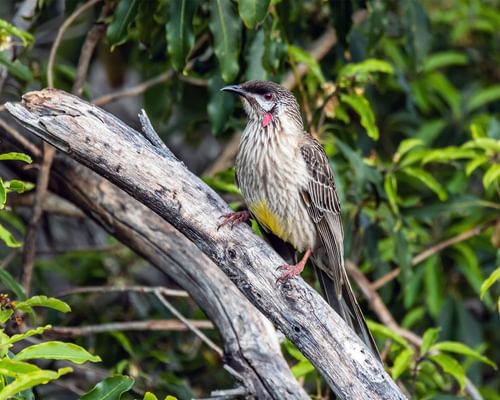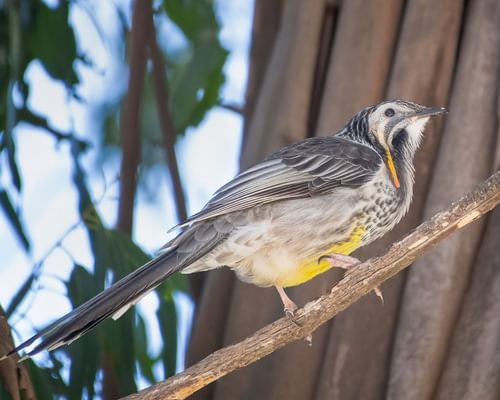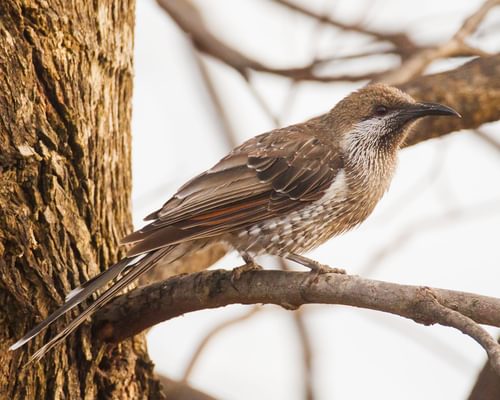Little Wattlebird
Least ConcernAnthochaera chrysoptera
Visual Identification
Appearance
The Little Wattlebird is a medium-sized honeyeater with a distinctive appearance. Its plumage is primarily brown and grey, with streaked patterns on the body and a pale patch on the belly. The bird lacks the fleshy wattles characteristic of other wattlebird species.
Adults have a long, curved bill and a brush-tipped tongue adapted for nectar feeding. Juveniles resemble adults but may have slightly duller plumage and less defined markings.
Size
Length
25cm to 30cm
Wingspan
35cm to 40cm
Weight
55g to 75g
Colours
Males and females have similar plumage
Primary Colour
Brown Grey
Secondary Colour
White Yellow
Beak Colour
Black
Leg Colour
Grey
Habitat and Distribution
Habitats
Woodland
Garden
Wetland
Coastal
Urban
Farmland
Grassland
Desert
Tundra
Rainforest
Mountain
Savanna
Distribution
Little Wattlebirds are endemic to Australia, found along the eastern and southern coasts from Queensland to South Australia, including Tasmania. They inhabit various woodland environments, including coastal heathlands, eucalyptus forests, and urban parks and gardens.
While primarily sedentary, some populations may undertake local movements in response to the flowering patterns of food plants. They are common in many Australian cities and adapt well to urban environments with suitable native vegetation.
Elevation Range
Sea level to 1,000 meters
Climate zones
Temperate, Subtropical
Distribution Map
This map gives you a rough idea of where you might spot a Little Wattlebird. The coloured areas show countries where these birds have been seen.
A few things to keep in mind:
- Birds might not be everywhere in the coloured areas, for example, they may be present around the coast of that country
- Where birds live can change with seasons and available food
- This map is quite simple - it doesn't show exact locations
We're working on making our maps even better! Soon, we hope to show you:
- More detailed maps for bigger countries, including state and region
- How birds move around during different seasons
Distribution by Region
Behaviour and Ecology
Bird Attributes
This feature is in beta. We'd love your feedback to improve it!
Share your thoughtsBird Attributes Explained
Our bird attributes system rates various aspects of a bird's capabilities on a scale of 0-100, based on data from field observations, scientific studies, and expert knowledge.
Attribute Categories:
- Agility: Manoeuvrability, speed, and grace in flight or movement.
- Strength: Physical power, often correlating with size and hunting abilities.
- Adaptability: Ability to thrive in various environments or changing conditions.
- Aggressiveness: Territorial behaviour and assertiveness, particularly during breeding seasons.
- Endurance: Stamina, often seen in migration patterns or foraging behaviours.
Understanding the Ratings:
- 0-20: Very Low
- 21-40: Low
- 41-60: Average
- 61-80: High
- 81-100: Very High
Remember, these attributes are relative to other bird species and don't necessarily indicate superiority.
Hover over the icon next to each attribute for more information.
Tap the icon next to each attribute for more information.
Agility
Reflects the bird's manoeuvrability, speed, and grace in flight or movement.
The Little Wattlebird demonstrates high agility, moving through vegetation with nimble hops and short flights. Their ability to hang upside down to reach nectar showcases exceptional manoeuvrability.
Strength
Indicates the bird's physical power, often correlating with size and hunting abilities.
As a medium-sized honeyeater, the Little Wattlebird possesses moderate strength. Whilst not particularly powerful, they are capable of defending territories and engaging in display flights.
Adaptability
Represents the bird's ability to thrive in various environments or changing conditions.
These birds show remarkable adaptability, thriving in various woodland environments from coastal heathlands to urban parks. Their success in colonising city areas with suitable native vegetation is particularly noteworthy.
Aggressiveness
Measures the bird's territorial behaviour and assertiveness, particularly during breeding seasons.
Little Wattlebirds are renowned for their aggressive territorial behaviour, frequently chasing away other birds from flowering plants. This high level of aggression is a key characteristic of the species.
Endurance
Reflects the bird's stamina, often seen in migration patterns or foraging behaviours.
Whilst specific endurance data is limited, their ability to defend territories year-round and engage in local movements following flowering patterns suggests good endurance. However, they are not long-distance migrants, which tempers this rating.
Diet
Little Wattlebirds primarily feed on nectar from native flowers, particularly eucalyptus, banksia, and grevillea. They supplement their diet with insects, especially during breeding season. These birds also consume fruits and have been observed drinking sap from tree trunks.
Behaviour
Little Wattlebirds are known for their aggressive territorial behaviour, often chasing away other birds from flowering plants. They move through vegetation with agile hops and short flights, frequently hanging upside down to reach nectar.
These birds are typically solitary or seen in pairs, becoming more social during the breeding season.
Vocalisation
Little Wattlebirds are known for their loud, harsh calls. Their repertoire includes a distinctive coughing or barking sound, often described as a repeated 'yak-yak-yak' or 'chock-chock'. They also produce softer, warbling notes during courtship and when communicating with their young.
Nesting & Breeding
The breeding season for Little Wattlebirds typically occurs from July to December. Pairs form monogamous bonds and may defend their territory year-round. Males perform display flights and vocalisations to attract females.
Nests are cup-shaped structures made of twigs, grass, and bark, often lined with softer materials. They are usually placed in the fork of a tree or dense shrub, 2-10 meters above ground. Females lay 2-3 pale pink eggs with reddish-brown spots.
Incubation lasts about 14 days, primarily carried out by the female. Both parents feed the chicks, which fledge after approximately 16 days. Young birds may depend on their parents for several weeks after leaving the nest.
Lifespan
years
The Little Wattlebird typically lives for 10 to 15 years.
Like all birds, lifespan can be affected by factors including predation, habitat quality, disease, and access to food sources.
Conservation and Status
Global Conservation Status
The Little Wattlebird is listed as Least Concern by the IUCN due to its large range and stable population. However, like many native Australian birds, it faces challenges from habitat loss and climate change. Conservation efforts focus on preserving native vegetation in urban and suburban areas.
Population Data
Global Population Estimate
Not quantified, but common [2]
Global Population Trend
Trend data may be uncertain or fluctuating
Birdwatching Tips
- Look for Little Wattlebirds in flowering trees and shrubs, especially eucalyptus and banksia.
- Listen for their distinctive harsh, coughing call, often heard before the bird is seen.
- Observe their aggressive behaviour towards other birds near food sources.
- In urban areas, check parks and gardens with native plantings.
Additional Information
Quick Facts
Other names:
Brush Wattlebird
Family:
MeliphagidaePredators
Main predators of Little Wattlebirds include birds of prey such as goshawks and falcons, as well as introduced mammals like cats and foxes in urban areas.
Did You Know?
- Despite their name, Little Wattlebirds lack the fleshy wattles found on other wattlebird species.
- Their brush-tipped tongue is specially adapted for feeding on nectar.
- Little Wattlebirds play an important role in pollinating native Australian plants.
Was this bird profile helpful?
Your feedback helps us improve our content
Thanks for your feedback!
Your input helps us improve our content.
Community Experience
Community Ratings
No ratings yet - be the first to rate this bird!
Latest Community Reviews
No reviews yet
Sign in to be the first to review
Community Reviews
Create Your Free Account Welcome Back!
Join our community to rate birds and share your experiences. Creating an account is completely free and only takes a minute. Sign in to your account to rate birds and share your experiences with our community.
Your information is secure and will never be shared.
By creating an account, you agree to our Privacy Policy.
Similar Birds
References
- 1
website: BirdLife International. 2017. Anthochaera chrysoptera (amended version of 2016 assessment). The IUCN Red List of Threatened Species 2017: e.T22704460A118664903.
View source - 2
report: Morcombe 2000; del Hoyo et al. 2008


